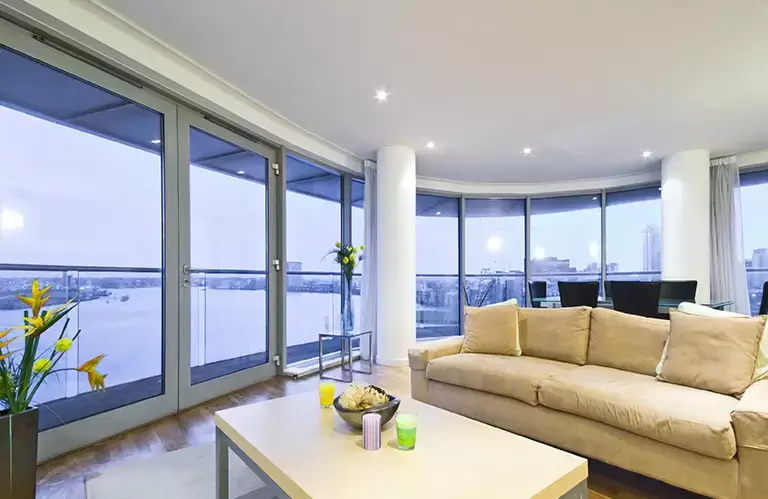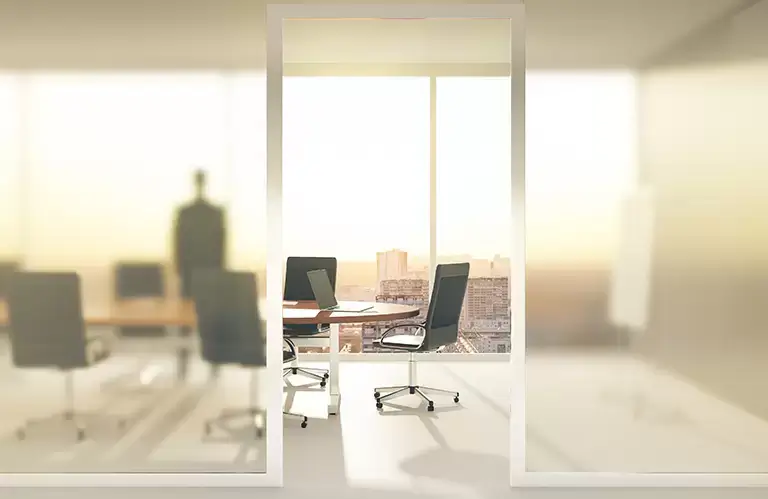The art of manufacturing glass is an old one. It was a process that has been refined for thousands of years. With technology becoming increasingly advanced, glass manufacturers have begun producing float glass that is much sturdier, durable and compatible with glass processing procedures of lamination, tempering, acid etching, sandblasting, etc. Skyscrapers shining with glass windows can be seen everywhere today. Homes with large French windows are in-trend. Glass partitions and shower walls are common to almost all homes today. Everything from cars to mobile phones utilizes glass.
History of Making Glass
The art of making glass can be traced back to 2600 BC in Mesopotamia. Egyptians practised making glass around 2500 BC. Artificial glass first appeared in the Egyptian or the Mesopotamian civilization, whereas they used tools made out of volcanic glass obsidian in the Stone Age. Ancient China, however, discovered how to make glass a little later.
Glass beads are known to be one of the earliest products made out of glass. Their creation is thought to be primarily accidental. In the later Bronze Age, glassmaking came to a halt. Glass was a luxury material back then.
Archaeological excavations suggest the use of glass in England during the middle ages. In the 10th century, stained glass found a place in cathedrals and windows of palaces. After the Renaissance, architectural methods changed substantially, leading to a decrease in stained glass as a building material. Domestic use of glass increased following the industrial revolution. Vessels, glass windows, and glass beads gained popularity in Europe during this period. During the 19th century, many people preferred glass windows and doors as a decorative option. In the late 19th century, some designers brought back stained glass in decorative windows. It was during this period that Mr Tiffany discovered several methods to make domed glass handicrafts.
People discovered the true versatility of using glass as a building material only in the 20th century. With glassmaking technology receiving an industrial boom, you could produce several different types of glass. Toughened glass, laminated glass, bulletproof glass, and smart glass all boosted the use of glass in buildings. Today, several skyscrapers, small and big homes, and offices use glass in almost all aspects of construction and design.
What Are Different Types of Glass?
Since glass has a wide variety of applications, it is of different types. Each of these varies in strength and design. In homes and offices, glass is used in everything from large windows to partitions and shower walls. New technology has enabled manufacturers to overcome the typical weaknesses of glass – brittleness, constant transparency and complete lack of sound control.

Based on the raw materials used, glass can be classified into the following types.
1. Fused Quartz or fused silica glass
This type of glass is highly resistant to weathering. Its molecules are arranged randomly. This type of glass is used in tube lights and furnaces.
2. Soda-lime silica glass
This type of glass is commonly used in windows and is one of the most prevalent types of glass made anywhere in the world.
3. Sodium Borosilicate glass
In this type of glass, boron oxide is added. It makes the glass less prone to cracking. It is primarily used to make lab equipment and kitchenware.
4. Lead Oxide Glass
Lead oxide glass has high reflective properties, making it a favourite of jewellery makers. Its crystals reflect light brilliantly.
5. Clear Glass
Also famous as float glass, clear glass offers extreme clarity and transparency for unobstructed views, making it the go-to choice for panoramic windows.

6. Tinted Glass
Commonly known as annealed glass, tinted glass is manufactured with a coating or a film to impart its colour and reduce light transmission.
Types of value-added Glass:
Apart from these, ordinary glass has been updated to accommodate various design choices to add value basis your glass needs. Some of the most unique and beneficial value-added glasses include the following.
1. Smart Glass
Smart glass, essentially a privacy solution, is a type of glass that can change its opacity at the click of a button. This type of glass is generally made using ions sandwiched between different glass layers. On the application of electric current, these ions shift positions to change the opacity of glass. Smart glass is widely used in both residential and commercial buildings. Smart glass, like AIS Swytchglass, is also considered to be ecologically efficient due to its ability to prevent/allow lighting and heat in a room.
2. Acoustic Glass
Like the name suggests, acoustic glass is used to control sound inside a room; thus, taking care of appropriate decibel needs or sound-control needs. It is the trendiest method to soundproof a living space or a commercial office. Acoustic glass is widely used in homes, recording studios and private offices. This type of glass is optimum for people who do not wish for bulky soundproofing.
3. Frosted Glass
Frosted glass is a privacy-solution value-added glass. It is not entirely transparent, which means it gives the benefit of privacy and partial visibility. It can be used in windows and partitions. Shower screens, doors, cabinet shelves and false ceilings also employ frosted glass. Frosted glass is used primarily by people desiring privacy, but it can also be a design choice. AIS Krystal Frosted Glass is the perfect way to ensure privacy while adding an aesthetic appeal to your living space.

4. Energy Efficient Glass
Energy-efficient glass is used in eco-friendly buildings to maintain a balance between aesthetics and eco-consciousness. It focuses on saving energy as it works by preventing or allowing solar radiation inside a room. AIS Ecosense is an energy-efficient glass curated, especially for Indian customers. AIS Ecosense enables a place to stay bright and fresh by limiting the solar energy entering a room. It comes in different varieties and can be used in both exterior and interior architecture.
Apart from these, several other glass types are used frequently in various industries. These include automotive glass, decorative glass, back-painted glass and laminated glass. Regardless of the sort, glass is a true blessing to humankind.
How Glass is made?
At Asahi India Glass Ltd., the highest quality glass manufacturing techniques are used to produce the perfect sheets of float glass. The method used is the PPG process that Sir Alistair Pilkington discovered in 1952 and is still the most trusted float glass manufacturing process. Naturally, it has many steps involved in it, and at each stage, great care is taken to be precise and thorough with the production of glass.

From selecting the right type and ratios of ingredients for glass to assimilating them all scientifically to produce glass as we know it, here we answer the question of how is glass made through a step-by-step process:
1. Melting and Refining
To make clear glass, need the right set of raw materials is required. This consists of silica sand (SiO2), sodium oxide (Na2O) from soda ash, calcium oxide (CaO) from limestone/dolomite, dolomite (MgO), and feldspar (Al2O3). These ingredients are mixed in the right proportion, and the entire batch is flown into a furnace heated to 1500 degrees Celsius.
To impart colour to the glass, certain metal oxides are also mixed in the batch.
2. Float bath
The molten material from the furnace flows into the float bath, consisting of a mirror-like surface made from molten tin. This material enters the bath at 1500 degrees Celsius and leaves the bath at around 650 degrees Celsius. Its shape at the exit is like a solid ribbon.
3. Coating for reflective glass
After that, if one is producing reflective glass surfaces that help keep indoors cooler, then coating procedures are followed in which either a hard coat or a soft coat is applied on the surface of the cooled ribbon at high temperatures.
4. Annealing
Next, a process called annealing is done to remove the internal stresses built up in the glass. This process allows the glass ribbon to pass through a layer that eliminates any pressures on the glass surface and gradually cools it to give it its final hardened form. This makes it easier to cut the glass and shape it accordingly.
5. Inspecting
More than 100 million inspections can be made through acute and advanced inspection technology throughout the glass manufacturing procedure to identify air bubbles, stresses, or grains of sand that refuse to melt. This is essential in quality-proofing the final form of glass.
6. Cutting to order
Finally, diamond steels are used to trim and cut the glass ribbons into square shapes.

Uses of Glass in construction and architecture
Over the years, glass has characterized modern architecture like no other material. Glass materials distinguish the look and feel of facades and have a crucial involvement in the energy efficiency of buildings.
The usage of glass in the commercial and residential sectors is increasing by leaps and bounds. This versatile material is now considered a symbol of affluence and luxury and gradually becomes an architect’s favourite.
Types of glass used in architecture
When it comes to architecture and design, glass offers various styles, such as tinted, float, double-glazed, solar control, etc. Each possesses qualities of its own.
Advantages of glass in architecture
Glass can make infrastructure look more stunning and sophisticated. That usage of glass in construction adds beauty to the building. Its use achieves the architectural view for external decoration. When used in the interiors, glass saves space too.
Glass cladding in buildings carries out the functional requirement of heat retention, lighting and energy-saving. It also adds a sense of ingenuousness and harmony to any surrounding.
How are AIS glass solutions different from the rest?
We offer various solutions depending on the need of your project and provide customized solutions to cater to your every need in a glass. We have products that are five times stronger than ordinary glass in the market. They allow architects and contractors to build the best architectural designs.
Why should you choose AIS Glass?
Design and durability:
By opting for AIS glass solutions, you are guaranteed to get designs that are durable, aesthetically pleasing and flexible in nature.
Safety and Security:
Our glass solutions offer better safety and security that make them the best option for use in high-security places.
Noise reduction:
Modern homeowners can also use our solutions to control sound levels and act as an effective insulator. If your office or home is situated near a busy market, railway station or airport, these solutions can be vital in keeping the sound out.
AIS Glass is India’s leading integrated glass manufacturing company, serving automotive, architectural, and consumer glass industries. We have over 13 glass sub-assembly units and pride ourselves in being a top-class glass. Our products are made with finesse and are customized according to the needs of our customers. Our innovative glass solutions include acoustic glass, AIS Swytchglass, AIS Securityglass, and AIS Décor. Our experts manufacture, shop and install your desired glass types and observe perfect standards in doing so. With AIS Glass, you can venture into a world of glass solutions meant to transform your lifestyle.






























